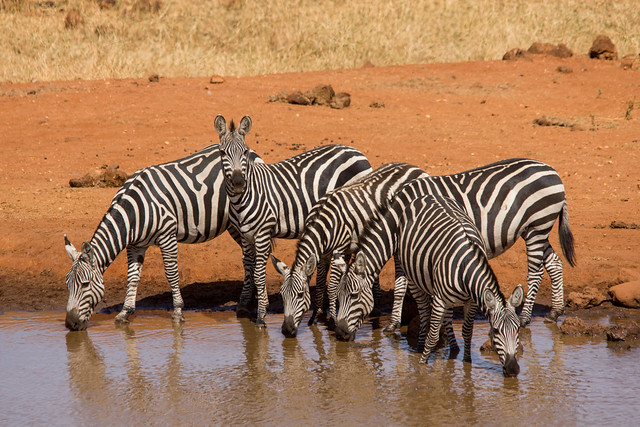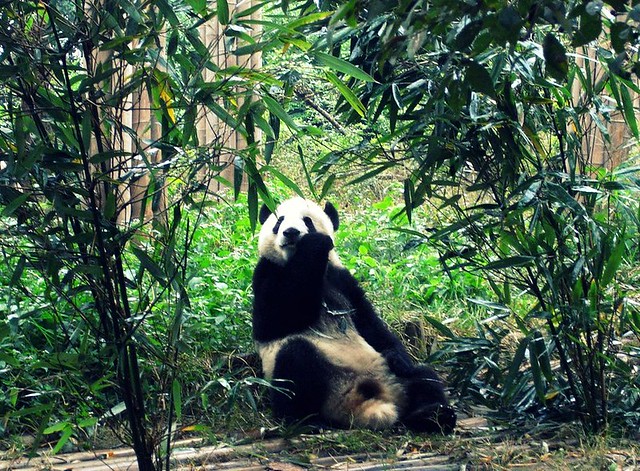世界自然保育聯盟(IUCN)4日更新「紅皮書」,提高多個物種的保護等級,包括以往常見的斑馬、羚羊。曾經是保育明星物種的大貓熊,保護等級則從瀕危降低為易危。
平原斑馬。圖片來源:Peter Steward(CC BY-NC 2.0)。
非法狩獵取皮 斑馬、羚羊如今成近危物種
曾經相當常見的平原斑馬(Plains Zebra)保護等級從無危提升至近危,因為過去14年間,數量從66萬減少24%至50萬。
在許多國家,平原斑馬只出沒在保護區內,但是1992年起,17個平原斑馬棲地國中,有十個國家個體數量減少。平原斑馬受到人類獵食和取皮的威脅,尤其是當牠們移動至保護區外時。
非洲的三種羚羊——騮毛小羚羊(Cephalophus dorsalis)、白腹小羚羊(Cephalophus leucogaster)和黃背小羚羊(Cephalophus silvicultor)——也從無危提升至近危。雖然在保護區內數量穩定,保護區外族群持續因為非法狩獵和棲地流失而減少。
「非法狩獵和棲地流失仍然是讓哺乳動物走向滅絕的主要原因。我們已經評估近半數的哺乳類,雖然有些保育成功案例,但新資料仍然顯示應注意持續走向瀕危的物種。」羅馬大學哺乳動物評估協調人隆達尼尼(Carlo Rondinini)說。
外來種威脅夏威夷生態 87%原生種瀕危
IUCN警告,豬、羊、鼠、水蛭和外來種植物入侵正在破壞夏威夷原生植物生態。夏威夷總共有1093種原生植物,IUCN評估了415種的存續風險,其中有38種被列入滅絕,四種被列入野外滅絕,87%有滅絕危機。
「夏威夷原生植物的存續危機可能發生在其他島嶼或是封閉生態系統。」IUCN SSC夏威夷植物專家小組成員基爾(Matt Keir)說。基爾呼籲立即想辦法阻止外來種的散佈,以保護數量稀少的物種。
此次發表的新資料將影響美國瀕危物種法保護的物種,確立控制外來種以及保護野外哺乳動物免於外來種威脅的資金。
IUCN專家指出,改善生物安全、防止外來種進入國境相當重要。
好消息:大貓熊、藏羚等保育有成
此次紅皮書更新也有好消息。由於森林保護和重建有成,過去被列為瀕危的大貓熊(Ailuropoda melanoleuca)保護等級降低為易危,顯示中國政府的保育措施確實有效。不過,氣候變遷預計將在80年內使大貓熊棲地竹林縮水超過35%,對大貓熊族群的影響將大於過去20年間的努力。要保護大貓熊,有效的森林保護措施必須持續下去,新的威脅也有待解決。
由於保育奏效,藏羚(Pantholops hodgsonii)的保護等級從瀕危降至近危。
1980年代和1990年代初期藏羚盜獵嚴重,數量從100萬大幅減少至6萬5000至7萬2500頭之間。其皮毛「shahtoosh」可製成昂貴的披肩,但是3到5頭藏羚才能製成一條,而且無法用剃或梳的方式取得,必須宰殺。經過政府嚴厲執法,目前數量約在10萬至15萬之間。
澳洲原生種刺巢鼠(Leporillus conditor)由於復育有成,從易危降至近危。復育方式包括重新引進至無天敵地區。刺巢鼠是僅存的築巢嚙齒類。牠的近親小刺巢鼠(Leporillus apicalis)已經於20世紀滅絕。刺巢鼠為築巢而分泌的樹脂,只要不碰到水,可以千年不壞。
澳洲原生種尖尾兔袋鼠(Onychogalea fraenata)也從瀕危降至易危。尖尾兔袋鼠曾經相當普遍,但在19世紀和20世紀初由於外來種入侵和棲地流失而大幅減少。移地復育措施成功在保護區內建立起新族群。
大貓熊。圖片來源:momo(CC BY 2.0)。
Today’s IUCN Red List update also reports the decline of the Plains Zebra, Equus quagga, due to illegal hunting.
The once widespread and abundant Plains Zebra has moved from a listing of Least Concern to Near Threatened. The population has reduced by 24 percent in the past 14 years from around 660,000 to a current estimate of just over 500,000 animals.
In many countries Plains Zebra are only found in protected areas, yet population reductions have been recorded in 10 out of the 17 range states since 1992. The Plains Zebra is threatened by hunting for bushmeat and skins, especially when they move out of protected areas.
Three species of antelope found in Africa – Bay Duiker, Cephalophus dorsalis, White-bellied Duiker, Cephalophus leucogaster, and Yellow-backed Duiker, Cephalophus silvicultor, – also have been moved from a listing of Least Concern to Near Threatened. While the populations of these species within protected areas are relatively stable, those found in other areas are decreasing due to continued illegal hunting and habitat loss.
“Illegal hunting and habitat loss are still major threats driving many mammal species towards extinction,” says Carlo Rondinini, coordinator of the mammal assessment at Sapienza University of Rome “We have now reassessed nearly half of all mammals. While there are some successes to celebrate, this new data must act as a beacon to guide the conservation of those species which continue to be under threat.”
The IUCN warns of the growing extinction threat to Hawaiian plants posed by invasive species.
Thirty-eight of the 415 endemic Hawaiian plant species assessed for this update are listed as Extinct and four other species have been listed as Extinct in the Wild, meaning they only occur in cultivation.
Invasive species such as pigs, goats, rats, slugs, and non-native plants are destroying the native plants of Hawaii. The latest results show that of the 415 endemic Hawaiian plant species assessed so far for the IUCN Red List – out of about 1,093 plant species endemic to Hawaii – 87 percent are threatened with extinction.
“What we see happening in Hawaii is foretelling what will happen in other island or contained ecological systems,” said Matt Keir, a member of the IUCN SSC Hawaiian Plant Specialist Group, urging action to stop the spread of invasive species and to protect species with small population sizes.
This new data will be used to influence action such as listing species under the U.S. Endangered Species Act, which will help to secure funding for conservation programs to target and control invasive species, and to fence wild areas to protect them from large mammals.
Improved biosecurity to stop invasive species from entering the country is essential, say IUCN experts.
This update of The IUCN Red List brings some good news for the Giant Panda and the Tibetan Antelope, demonstrating that conservation action can deliver positive results.
Previously listed as Endangered, the Giant Panda, Ailuropoda melanoleuca, is now listed as Vulnerable, as its population has grown due to effective forest protection and reforestation.
The improved status confirms that the Chinese government’s efforts to conserve this species are effective. Still, climate change is predicted to eliminate more than 35 percent of the Panda’s bamboo habitat in the next 80 years and as a result, the Panda population is projected to decline, reversing the gains made during the last two decades.
To protect this species, it is critical that the effective forest protection measures are continued and that emerging threats are addressed.
Due to successful conservation actions, the Tibetan Antelope, Pantholops hodgsonii, has been moved from a listing as Endangered to Near Threatened.
The population underwent a severe decline from around one million to an estimated 65,000-72,500 in the 1980s and early 1990s. This was the result of commercial poaching for the valuable underfur, called shahtoosh, which is used to make shawls. It takes three to five hides to make a single shawl, and as the wool cannot be sheared or combed, the animals are killed. Rigorous protection has been enforced since then, and the population is currently likely to be between 100,000 and 150,000.
Other conservation successes include the Greater Stick-nest Rat, Leporillus conditor, endemic to Australia, which has improved status, moving from Vulnerable to Near Threatened. This is due to a successful species recovery plan, which has involved reintroductions and introductions to predator-free areas. This unique nest-building rodent is the last of its kind, with its smaller relative the Lesser Stick-nest Rat, Leporillus apicalis, having died out in the 20th Century. The resin created by the rats to build their nests is so strong that they can last for thousands of years if they are not exposed to water.
The Bridled Nailtail Wallaby, Onychogalea fraenata, has also improved in status, having been moved from Endangered to Vulnerable. Endemic to Australia, this once common species had a steep population decline during the 19th and early 20th centuries due to the impacts of invasive species and habitat loss. A successful translocation conservation program establishing new populations within protected areas is enabling this species to begin to recover.
※ 全文及圖片詳見:ENS






